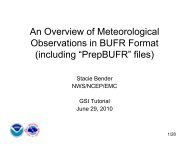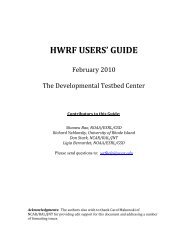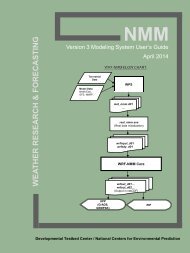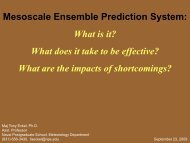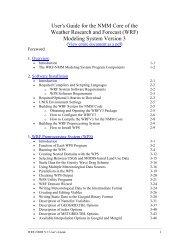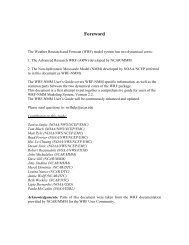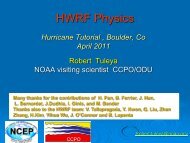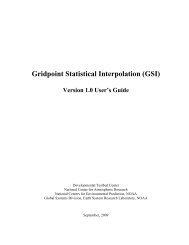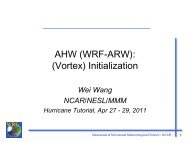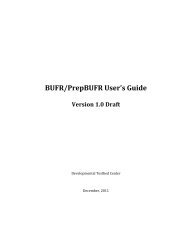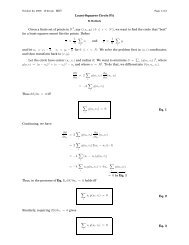Vijay Tallapragada EMC/NCEP/NOAA
Vijay Tallapragada EMC/NCEP/NOAA
Vijay Tallapragada EMC/NCEP/NOAA
You also want an ePaper? Increase the reach of your titles
YUMPU automatically turns print PDFs into web optimized ePapers that Google loves.
WRF for Hurricanes Tutorial, Boulder, CO<br />
24 th February, 2010<br />
<strong>Vijay</strong> <strong>Tallapragada</strong><br />
<strong>EMC</strong>/<strong>NCEP</strong>/<strong>NOAA</strong><br />
Acknowledgements: HWRF Team Members at <strong>EMC</strong>, DTC, GFDL and URI
• Overview of the operational coupled HWRF<br />
System<br />
• Modifications to the operational HWRF model for<br />
tutorial and public release<br />
• Components of the HWRF Model<br />
• HWRF Dynamics (specific to movable nested grid and<br />
coupling)<br />
• HWRF Physics<br />
• Vortex Initialization<br />
• Coupler and POM TC<br />
• Postprocessing and vortex tracker
The Weather Research and Forecast Modeling System for<br />
Hurricanes (HWRF) was designed and developed at <strong>NCEP</strong>/<br />
<strong>EMC</strong> to address the Nation’s next generation hurricane<br />
forecast problems.<br />
HWRF became operational in the year 2007 preceded by<br />
extensive testing and evaluation for three hurricane seasons<br />
(2004-2006), and has been constantly improved to increase<br />
the forecast skill for track, intensity and structure of Atlantic<br />
and Eastern Pacific hurricanes.<br />
The atmospheric component of HWRF is a configuration of<br />
the general WRF code. The use of same code by research<br />
and operation will facilitate O2R and R2O.
HWRF will be a Reference Configuration<br />
for WRF NMM (Essential step towards<br />
O2R and R2O)<br />
Transition to<br />
Operations at<br />
<strong>NCEP</strong>/<strong>EMC</strong><br />
HWRF
HWRF code management:<br />
a new mechanism to facilitate collaboration between research and operations<br />
WRF Repository<br />
Extensive Testing<br />
Feb 2011?<br />
03/2010<br />
07/2009<br />
04/2009<br />
04/2008<br />
WRF V3.2+<br />
WRF V3.2<br />
WRF V3.1.1<br />
WRF V3.1<br />
WRF V3.0<br />
HWRF configuration for operations (2011)<br />
upgrades<br />
2011<br />
12/2006<br />
WRF V2.2<br />
08/2005<br />
WRF V2.1<br />
05/2004<br />
WRF V2<br />
oper<br />
HWRF<br />
2007<br />
oper<br />
HWRF<br />
2008<br />
oper<br />
HWRF<br />
2009<br />
oper<br />
HWRF<br />
2010
The HWRF Modeling System<br />
<br />
<br />
<br />
<br />
<br />
<br />
<br />
Regional-scale, moving nest, Ocean-Atmosphere coupled modeling system specially designed<br />
to advance hurricane forecasts.<br />
Makes use of WRF infrastructure for computational efficiency<br />
Non-hydrostatic system of equations<br />
<br />
<br />
rotated latitude-longitude, Arakawa E-grid<br />
vertical pressure hybrid (sigma-P) coordinate.<br />
NMM dynamics modified for inclusion of<br />
<br />
<br />
movable nested grid<br />
coupling to ocean model (POM-TC)<br />
HWRF vortex initialization includes<br />
<br />
<br />
<br />
vortex relocation,<br />
correction to winds, MSLP, temperature and moisture in the hurricane region<br />
adjustment to actual storm intensity.<br />
Physical parameterization schemes designed and tested for tropical purposes<br />
Ocean coupled modeling system (POM-TC of URI).
Outer (Parent) 216X432 0.18 O (~27 km), 42 levels<br />
Inner (Movable Nest)<br />
60x100, 0.06 o (~9 km)<br />
POM-TC United domain<br />
1/6 o horizontal, 23 levels<br />
Atmospheric domain<br />
about 75 o x 75 o
WRF Pre-processing System (WPS)<br />
Domain Specification and grid selection<br />
Interpolation of GFS forecast grib files to generate real data<br />
WRF Model (HWRF dynamical core and HWRF Physics)<br />
Initialization programs for real (real.exe – same as NMM<br />
dynamical core)<br />
Numerical integration program (wrf.exe)<br />
HWRF Initialization Software<br />
Ocean Model and Coupler<br />
WRF Post-Processing Program (WPP)<br />
Vortex tracker<br />
Graphical utilities for both HWRF and POM
Running WPS<br />
Several executable stages with namelist input<br />
geogrid.exe (interpolate maps and time-independent fields)<br />
ungrib.exe (convert time-dependent Grib-formatted data to simple binary<br />
format)<br />
metgrid.exe (interpolate time-dependent initial and boundary data)<br />
Must chose a pre-determined configuration for both parent<br />
and nested domains.<br />
Outer domain (0.18 deg. Resolution – approx. 27 km; grid<br />
size: 216x432) and inner nest centered on storm location<br />
information obtained from tcvitals (0.06 deg. Resolution,<br />
approx. 9 km; grid size: 60x100)<br />
real_nmm.exe will then sets up vertical model levels for<br />
three-dimensional model input and boundary conditions
For atmospheric vortex initialization:<br />
Run atmospheric model to generate “analysis”<br />
domain (to generate data for inner nest) and a<br />
“ghost” domain (about 4 times larger than the inner<br />
nest, used for the purpose of vortex initialization).<br />
Both these domains have same resolution (9 km)<br />
Run vortex initialization procedure (contains<br />
multiple stages and spans several executables)<br />
More details on HWRF<br />
setup by Shaowu Bao
Figure provided by Shaowu
Modifications to WRF-NMM dynamic core specific<br />
to HWRF configurations include<br />
Vortex following two-way interactive movable nest<br />
Nest motion based on variations in dynamic pressure<br />
“Stagnation point” as the center of the storm<br />
Horizontal diffusion effect from TKE set to zero<br />
Solve_nmm.F modified to include insertions related to<br />
Coupler (send fluxes from atmosphere to ocean and<br />
pass SSTs from Ocean to atmosphere)<br />
Momentum mixing tendency terms from SAS scheme<br />
More details on HWRF<br />
dynamics by Young Kwon
Details specific<br />
to nested grid<br />
computations<br />
All interpolations are done on a rotated lat-lon, E-<br />
grid with the reference lat-lon located at the centre<br />
of the parent domain.<br />
<br />
<br />
<br />
Consequently the nested domain can be freely<br />
moved anywhere within the grid points of the<br />
parent domain, yet the nested domain lat-lon lines<br />
will coincide with the lat-lon lines of the parent<br />
domain at integral parent-to-nest ratio.<br />
This coincidence of grid points eliminates the need<br />
for more complex, generalized remapping<br />
calculations in the WRF Framework.<br />
Because of the E-grid structure and the fact that<br />
the input interface is well separated from dynamic<br />
interface, boundaries are updated at every time<br />
step of parent domain similar to how parent<br />
domain is updated at the mass point from the<br />
external data source (bc’s) .<br />
More details on nesting<br />
by Gopal
HWRF model consists of advanced physical<br />
parameterization schemes adopted from GFS<br />
model and used by the highly successful GFDL<br />
hurricane model.<br />
SAS convection scheme, GFS/GFDL surface<br />
and boundary layer physics, GFDL/GFS<br />
radiation and Ferrier Microphysical Scheme.<br />
More details on HWRF<br />
Physics by Bob Tuleya
HWRF model uses an advanced vortex<br />
initialization procedure to represent model’s initial<br />
storm location, intensity and structure based on<br />
observed estimates provided by NHC.<br />
Coordinates of the observed position of the storm<br />
are used to relocate (correct) the storm’s initial<br />
location.<br />
A blend of synthetic vortex and storm perturbation<br />
from previous cycle’s 6-hr forecast (if available) are<br />
used to adjust (correct) storm’s initial, intensity<br />
and size to match the observed estimates.
Flow Chart by Ligia Bernardet<br />
More details on HWRF<br />
vortex initialization by<br />
Qingfu Liu
HWRF model is coupled to Princeton Ocean Model (POM) in<br />
the Atlantic to provide accurate SST fields as input to HWRF.<br />
POM model is driven by heat, radiative and momentum<br />
fluxes passed from HWRF and the SST response from POM<br />
is transferred back to HWRF.<br />
POM employs a sophisticated ocean initialization procedure<br />
to properly account for the cold wake generated by storm’s<br />
passage, and accurately represent gulf stream, warm and<br />
cold core eddies.<br />
A sophisticated “Coupler” was designed to enable exchange<br />
of information between the atmosphere and ocean during<br />
the model integration.
POM-TC is initialized with a realistic, three-dimensional<br />
temperature and salinity field and subsequently integrated<br />
to generate realistic ocean currents and to incorporate the<br />
preexisting hurricane-generated cold wake<br />
Ocean initalization employs a feature-based modeling<br />
procedure that incorporates historical and near-real time<br />
observations of the ocean to accurately represent the<br />
spatial structure and location of oceanic fronts including<br />
gulf stream, loop current, warm and cold core eddies.<br />
More details on POM-TC<br />
initialization by Rich Yablonsky
A generalized coupler code was developed at<br />
<strong>NCEP</strong> to act as an independent interface<br />
between atmospheric (HWRF) and oceanic<br />
(POM) components.<br />
Coupler handles all grid interpolations (both<br />
coarse grid and fine grid) and facilitates<br />
passing information between HWRF and POM.<br />
More details on <strong>NCEP</strong> Coupler by<br />
Rich Yablonsky
Time integration of HWRF coupled model is done using three executables<br />
working in MPMD mode (multiple program multiple data).<br />
Coupler serves as a hub for MPI communications between HWRF and POM and<br />
performs the interpolation of the surface fluxes from the fixed and moving<br />
HWRF grids to the POM grid and of the SST from the POM grid to the two HWRF<br />
grids.<br />
Stand-alone atmospheric HWRF can be run for all oceanic basins (East-Atlantic<br />
and Eastern Pacific) and for all storms with constant SST forcing.<br />
Use HWRF specific namelist file containing description of grid dimensions,<br />
time steps, options for HWRF physics and controls for history interval<br />
Not much of a choice to make changes as the codes are configured to run<br />
pre-determined (somewhat hardwired) options<br />
Forecast integration is done in MPMD mode, using three executables (WRF,<br />
POM and Coupler). For a typical model run at <strong>NCEP</strong> (operations), WRF uses<br />
78 processors, POM and Coupler run on single processor each. A command<br />
file is generated to assign these tasks to load-leveler on IBM.<br />
More details on HWRF coupled model<br />
integration by Shaowu & Ligia
Post-processing of HWRF output (both wrfout_d01 and wrfout_d02<br />
files) is done using WRF Post-Processor developed at <strong>NCEP</strong> (WPP).<br />
WPP generates output in standard grib format. Output from parent<br />
domain is post-processed to a uniform grid resolution of 0.25 deg.<br />
lat/lon and the output from nested grid is post-processed to 0.1<br />
deg. lat/lon resolution.<br />
A selected set of variables (required for vortex tracker) are collected<br />
from both parent and nest grib files and combined to generate 0.1<br />
deg. resolution output for the entire domain. These include u, v<br />
components of wind at 10m, 850, 700 and 500 hPa; absolute<br />
vorticity and geopotential height at 850 and 700 hPa and mean<br />
sea-level pressure.<br />
More details on HWRF postprocessing<br />
by Jamie Wolf
A unified vortex tracking algorithm was<br />
developed at GFDL and is used at <strong>NCEP</strong> to<br />
track the storm movement and intensity in the<br />
model output.<br />
The grib files on “combined” domain are<br />
provided as input to the vortex tracker, which<br />
generates storm track forecast files in ATCF<br />
format.<br />
More details on Vortex Tracker by<br />
Tim Marchok
HWRF model output on native grid is in rotated lat/lon (Egrid),<br />
and cannot be be viewed using several standard<br />
visualization tools including NCL, MATLAB, IDL as they<br />
cannot ingest the staggered E-grid format. However, there<br />
are many tools including “RIP” that can facilitate projecting<br />
the output into graphical form.<br />
HWRF model output in GRiB format (from WPP) can be<br />
viewed using several software including GrADS, GEMPACK<br />
etc. A set of sample GrADS and GEMPACK scripts are<br />
provided with the distributed software.<br />
POM model output is in standard FORTRAN binary format,<br />
and a set of sample GrADS scripts are provided to visualize<br />
ocean model output.<br />
More details on HWRF<br />
practical sessions and<br />
graphics by Shaowu Bao
Limitations of DTC supported HWRF model<br />
HWRF V3.2 configuration is somewhat hard-wired to match the<br />
operational HWRF configuration. Limitations include:<br />
Can’t change dimensions of either parent or nest domains (due to vortex<br />
initialization and coupling requirements)<br />
Can’t add more nests (telescopic or secondary)<br />
Limited flexibility of options for physics (not all combinations are tested)<br />
Currently, coupling is supported only for the “United” region of Atlantic<br />
basin of POM-TC.<br />
Data assimilation procedures (including GSI) are not currently included<br />
or supported for this version.
Apart from canned cases for tutorial purpose, atmospheric HWRF (stand-alone) can<br />
be run for any storm in the Atlantic or Eastern Pacific basin provided GFS initial and<br />
boundary conditions are obtained. Coupled model can be run for any storm in the<br />
Atlantic (united domain) – if data for loop current and/or warm/cold core eddies is<br />
not present, POM-TC initialization uses climatology.<br />
<br />
Sources of GFS Data<br />
<br />
<br />
<strong>NCEP</strong> Final Analysis (FNL from GFS, freely available from<br />
http://dss.ucar.edu/datasets/ds083.2/<br />
GFS forecast data from NOMADS (http://nomads.ncdc.noaa.gov/dods/<strong>NCEP</strong>_GFS)<br />
<br />
For POM-TC<br />
<br />
<br />
Data for loop current and warm/cold core eddy available from DTC for selected storms of<br />
2005 and 2008/2009 Atlantic.<br />
Need to provide initial SST, land-sea mask and grid information for these files (not<br />
currently supported)
Current (2009) Operational HWRF Configuration (based on HWRF V2.0)
HWRF Coupled Model is designed to run on<br />
massively parallel clusters like <strong>NCEP</strong> and NCAR<br />
IBM machines. The distributed version of<br />
HWRF runs on <strong>NOAA</strong>’s WJET and NJET<br />
machines.<br />
Due to its complex nature, although portable to<br />
other Linux clusters, HWRF modeling system is<br />
too big and requires too much resources for<br />
execution on other machines.
Students will learn<br />
How to obtain and compile the HWRF software<br />
How to initialize HWRF model, WPS and vortex<br />
initialization<br />
How to initialize POM<br />
How to configure and run HWRF coupled modeling<br />
system (cold start as well as cycling)<br />
How to post-process HWRF and POM model output<br />
How to generate track forecast files<br />
More details on practical sessions<br />
by Shaowu Bao and Ligia Bernardet
Following is the schedule of components specific to HWRF<br />
tutorial:<br />
Wednesday 02/24/2010 Thursday 02/25/2010<br />
12:45 HWRF physics<br />
1:30 HWRF dynamics<br />
1:45 HWRF nesting<br />
3:30 HWRF vortex initialization<br />
Friday 02/26/2010<br />
8:30 HWRF - set up and run analysis,<br />
relocation, vortex<br />
9:30 Practical Session<br />
8:30 HWRF ocean<br />
10:30 HWRF - how to set up and<br />
run WPS and WRF<br />
1:00 Practical Session<br />
3:45 WRF Post-processor<br />
4:30 Vortex Tracker
If you have any questions regarding HWRF,<br />
please write to wrfhelp@ucar.edu



